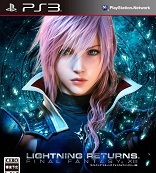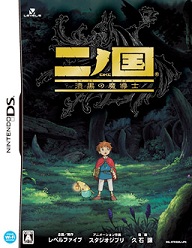« White Knight Chronicles stateside release date set | Main | Handheld RPG scans 12/6/09 »
Remembering the RPGs of 2001
By Heath | December 5, 2009 at 12:48 pm
It would be a year that saw two new consoles and a new handheld hit the market. It would see gamers from across the world link up and cooperate — not on a PC, but on a game console. It would mark the first time Final Fantasy used voice acting. It would deliver two still-standing, top-tier MMORPGs. It was the first year of the millenium to not end in a 0. It was 2001.

In January of 2001, it was Sega kickstarting things with Phantasy Star Online for the Dreamcast. Liking it or disliking it is secondary to accepting that it was definitely groundbreaking. RPG players had cooperated with each other via PC MMOs before; this was no longer hot news by 2001. Gamers had also taken part in same-console multiplayer for years prior to this. PSO, however, marked the first time RPG players could link up and cooperate online without a computer, but on a video game console. Its action RPG stylings and biggest focus being its online-only multiplayer, some traditionalists were upset that the beloved Phantasy Star series had gone this way, despite having a full offline mode. Phantasy Star Online is sometimes falsely labeled an MMORPG; it was not one. Online cooperation it did have, but not nearly on the “massive” scale that helps define an MMO, and all combat areas were private. One could not stumble into another party and be like “Whoa.” A Version 2 of the game would be release later in this same year.

The Dreamcast got more love in February with Record of Lodoss War, based on the anime of the same name. It was a hack-and-slasher in the vein of Diablo that would prove pretty polarizing. February 2001’s real buzz was when Mario went 2D in a game for the quickly dying Nintendo 64. Check that, the game wasn’t really 2D so much as Mario himself had become…paper. Here’s a commercial.

“The Zelda Killer!” Remember the hype surrounding Dark Cloud? I saw it labeled “Sony’s Zelda-killer” by two different magazines in mid 2001. Upon last check, the original Dark Cloud is regarded as an average-grade action RPG, and no Zelda games were harmed or killed during its market run.
Having seen some success with the release of 1999’s Final Fantasy Anthology — which ported Final Fantasy V and VI from Super Nintendo to PlayStation — Squaresoft decided to bundle up some more SNES games and re-release them on PlayStation in 2001. This time, Final Fantasy IV (formerly called Final Fantasy II outside of Japan) and Chrono Trigger would get the port treatment. Chrono Cross, released the previous year, had sparked a lot of interest in the game’s elder, both from those playing Cross first and those whose nostalgia buttons had been pushed, so it seemed a fine move. The two would be bundled together, given some new movie sequences and called Final Fantasy Chronicles.

The online gaming boom was still…um…booming, and the market was ripe. Funcom’s Anarchy Online and Mythic’s Dark Age of Camelot would come along and rock the MMO world in 2001, the former in June and the latter in September. Anarchy set itself apart by making guns the main weapons and space the setting, while DAoC’s eventual addition of innovative large group combat dubbed “Realm vs. Realm” put Mythic on the map as a seriously talented MMO developer. Both are still alive and kicking today, and in the opinions of many, are two of the coolest out there.
Tactical RPG Saiyuki: Journey West arrived on the scene in August, selling approximately 11 copies nationwide. The game was based on piece of popular Asian mythology and featured the ability for characters to turn into giant friggin’ monsters on the battlefield for limited times. It was also somewhat unique in not having dozens of recruitable characters, but rather the same handful all game long.
Other than Game Boy Color’s Pokémon Crystal in July, and the few above-mentioned games, that summer didn’t see much more love. On the bright side, but not literally all that bright, the Game Boy Advance said “Hello” to the world in June. Castlevania: Circle of the Moon would be its headlining RPG pretty much until the holiday season, when the little, colorful-yet-unable-to-be-played-it-the-dark machine would be graced with Golden Sun, Mega Man Battle Network, and a port of the original Breath of Fire. Despite me being too old for “those silly games,” my mom got me a GBA for Christmas that year. I love you, mom.
Meanwhile, Game Boy Color, in its last year of glory, didn’t exactly go out with a bang; its co-headlining RPGs in 2001 were Lufia: The Legend Returns and Dragon Warrior III (in these days, Dragon Quest games were still renamed Dragon Warrior outside of Japan due to trademark restrictions). The Legend Returns had a unique battle system, but that wasn’t enough to satisfy the watery mouths of Lufia II fans that had heard about a handheld sequel. Dragon Warrior III, among the series’ strongest entries in the opinions of many, was a modified port of the NES classic and gave younger RPG lovers a taste of the older days.
But III would bot be the only Dragon Warrior hitting North America in 2001; the fall brought Dragon Warrior VII, the series’ first new console title since the days of Super Nintendo, and first to venture outside of Japan since 1992’s Dragon Warrior IV for the Nintendo Entertainment System.
In September, Tales of Eternia would be renamed Tales of Destiny II and launch in North America. Gamers may have perhaps been a little stunned to not see Stahn and Rutee running around onscreen. The actual Tales of Destiny II came out later, for PlayStation 2, only in Japan. This still causes confusion in some RPG conversations.


November would see the console war really begin in full. For the whole year before, there’d been plenty of buzz about Nintendo’s “Dolphin.” Later, it was named the much more literal “GameCube.” The blue box launched in North America in November of 2001, but our friends in PAL territories would have to wait until May of 2002 to get the machine. The only RPG it would get within 2001 was Baldur’s Gate: Dark Alliance, which also appeared on almost every other system. Nintendo’s marketing was a little weird. GameCube can attribute some of its initial success to the Nintendo name and being priced a hundred bucks cheaper than the PS2 and Xbox ($200 as opposed to $300 for the other machines).
And speaking of the Xbox, Microsoft was the subject of a lot of mystified criticism before and during the early Xbox days. After all, “What [were] they thinking, trying to get into a console market and trying to compete with longtime powerhouse Nintendo, newfound king of the mountain PlayStation, and Sega’s high-tech Dreamcast?” Its November 2001 (North American) launch was less than spectacular, especially from an RPG perspective. Like the ‘Cube, it only had Dark Alliance going for it. The MS marketing team also apparently had fun making its commercials. Some of them were a little creepy though.
December brought expected amounts of game releases, among them being a sequel to the PlayStation’s obscure RPG Jade Cocoon and a tactical RPG called Hoshigami: Ruining Blue Earth. The most widely remembered RPG release of that month, however, would be Final Fantasy X. The first Final Fantasy of the new generation, FFX marked the series’ first use of a voice-acted script. It made people scream. For development, the game stuck characters on a grid of interconnected spheres, all of which were worth stat upgrades or ability acquisitions. Every character was on the same grid, but they all started in a different location, making them very distinct at first but eventually able to have similar strengths. As with every Final Fantasy title, this feature and others would be seen as heavenly to some and wholly rejected as blasphemy in the eyes of others.

Shadow Hearts, a sequel to super-unknown four-disc PlayStation RPG Koudelka, would round out the RPG December of 2001. Marketing reasons distanced it from Koudelka, as Midway wanted players to be assured they could jump into this game without playing the original. This title would be far more successful than its elder, gaining acclaim for its Judgment Ring battle system and loose use of actual historical events and characters.
Coming soon is the look back at 2002. It would be a year of sequels containing 3’s, opposites mashing together, and the blood of the console war being spilled on the faces of screaming gamers.
RPG System of the Year 2001: Dreamcast. Phantasy Star Online was a huge step for console RPGs, nay, for consoles’ online play in general. True, the machine’s best RPGs were already out in 2000, but this huge jump coupled with a few other decent RPG experiences (and somewhat weak showings on other systems) put the Dreamcast in the top spot in 2001.
Did you miss the look back at 2000? It was an awesome year for RPGs, so you’ll wanna check out that nostalgia trip here. Share your thoughts on the year 2001 via email, forums, or Facebook.
Relevant Links:
RPG Land Remembers 2003
RPG Land Remembers 2002
Topics: Games of the Decade, Specials
















